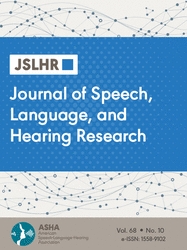Abstract
Purpose:
Existing literature suggests that musical experience can enhance the auditory perception of acoustic features. However, it remains unclear whether such improvements in acoustic processing affect speech perception in older adults. The present study aimed to explore whether older adults with amateur choir experience can exhibit finer processing of acoustic features in perceiving Mandarin sounds than those without such experience, as indicated by hemispheric lateralization patterns in processing acoustic attributes of Mandarin sounds and the performance in lexical tone identification based on different acoustic cues.
Method:
Two experiments were conducted in this study. Experiment 1 compared the performance of older adults with and without amateur choir experience in dichotic listening tasks based on consonant–vowel (CV) syllables varying in consonants, vowels, and lexical tones. Experiment 2 examined the performance of two groups of older adults in identifying Mandarin tones under the fundamental frequency (F0)-only (with equal durations) and F0 + duration (with natural durations) conditions.
Results:
Experiment 1 revealed that older adults with amateur choir experience demonstrated an analytical processing mode for time and frequency features of speech sounds, as evidenced by more pronounced left-hemispheric lateralization in dichotic listening tasks based on CV syllables varying in consonants and in lexical tones. Furthermore, Experiment 2 showed that older adults with choir experience exhibited better performance than those without such experience in lexical tone identification under both the F0-only and F0 + duration conditions.
Conclusions:
The amateur choir experience may lead to an analytical processing mode of time and frequency features and boost the identification accuracy of Mandarin sounds based on these cues in the aging population. These findings substantiate the overlap, precision, emotion, repetition, and attention hypothesis and highlight the beneficial impact of amateur choir experience on speech perception.
原载Journal of Speech, Language, and Hearing Research, 68(10), 4978-4995.

